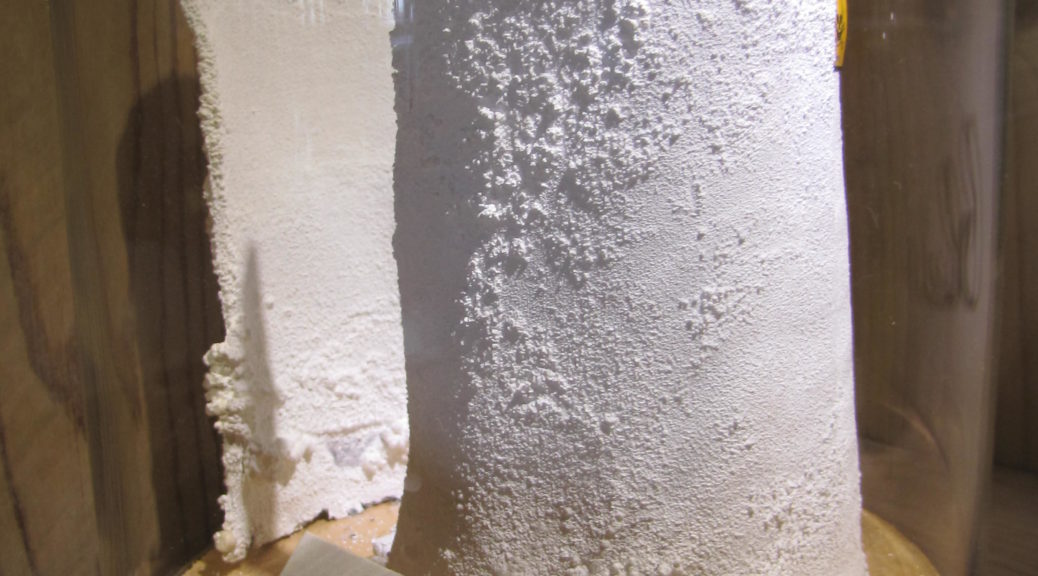
Sugar of Lead
Today’s article may be the last of the “Science Lite” posts since by this time next week, we may be unpacked enough to resume normal life after the moving across the country. | Everyone knows there’s a problem with little kids eating paint chips because of the danger of lead poisoning. The real culprit is not even the main lead-based white pigment but rather a lead-based contaminant found in lower-quality paints. The antiquaited name for this contaminant was sugar of lead.
LEAD WHITE
The pigment known as lead white is the queen of all white pigments. It has the highest opacity of all the white pigments. Chemists call it basic lead carbonate and it has a formula of 2PbCO3·Pb(OH)2. When it occurs in nature, it is the mineral hydrocerussite, which is an uncommon secondary mineral found in the oxidized portions of lead deposits.
THE MANUFACTURE OF LEAD WHITE
The long-dead Roman Pliny the Elder documented the oldest method of making lead white pigment almost two thousand years. This method has remained mostly unchanged into the twentieth-first century. Regardless, because of the problems of modern-day lead poisoning, no one makes lead-white pigment in large quantities anymore. Today, only a few specialty firms produce a very small amount of lead white for use by artists.
Making lead white is a two step process.
- To begin the first step, a color manufacturer suspends strips of lead above acetic acid in a sealed container.
- Historically, the acetic acid solution was vinegar.
- Next, the acidic fumes react with the surface of the lead and a crust of lead acetate forms. Lead acetate has a formula of Pb(CH3COOH)2.
There are two different ways to achieve the second step in the process.
- Both Pliny and the ancient Greek Theophrastus described the first: Workers first scraped the lead acetate off the lead strips and then they boiled it. After boiling, the residue at the bottom of the pot was the lead white pigment.
- The second way to achieve the second step is the Dutch process.
- In this method, the containers of lead and vinegar were buried in a pit.
- Compost was heaped on the containers to provide both heat and carbon dioxide.
- The lead acetate reacted with the carbon dioxide from the compost.
- The reaction was slow so it took months to convert all the lead acetate in the exothermic heat from the decay of the compost.
- The final product was basic hydrous lead carbonate, which is the most saturated and opaque of all white pigments.
A MATTER OF TASTE
Pure lead white, which is basic hydrous lead carbonate, has a metallic taste to it. It was not the problem in the child poisonings from lead paint. The problem was the incomplete conversion of lead acetate into pure lead white pigment.
- Incomplete conversion could occur with either the boiling process or the Dutch process.
- Unconverted lead acetate is almost as white as the pure lead white carbonate-based pigment.
- It was not practical to remove the lead acetate contaminant in the lead-white pigment sold for making paint.
Lead acetate has a sweet taste. It’s so sweet that it used to be called “sugar of lead.” It is as sweet as white sugar. Flakes of white paint containing lead acetate taste like candy to infants and toddlers who, as we all know, have a habit of putting all sorts of stuff in their mouths.
So now you know why there was a great push to get rid of lead-white paints, especially for paints used inside buildings where children lived. Nibbling on chips and flakes of lead white paint poisoned a lot of small children. As a consequence, those kids often suffered permanent brain damage. They ate the paint because the paint flakes tasted sweet. That sweetness came from the sugar of lead which failed to transform into basic lead carbonate during the pigment-making process.
Credits
The banner image for today’s post is a photo of a lead acetate crust rowing on a substrate of a metallic lead toll, by Concord (Own work), CC BY-SA 3.0, via Wikimedia Commons.
